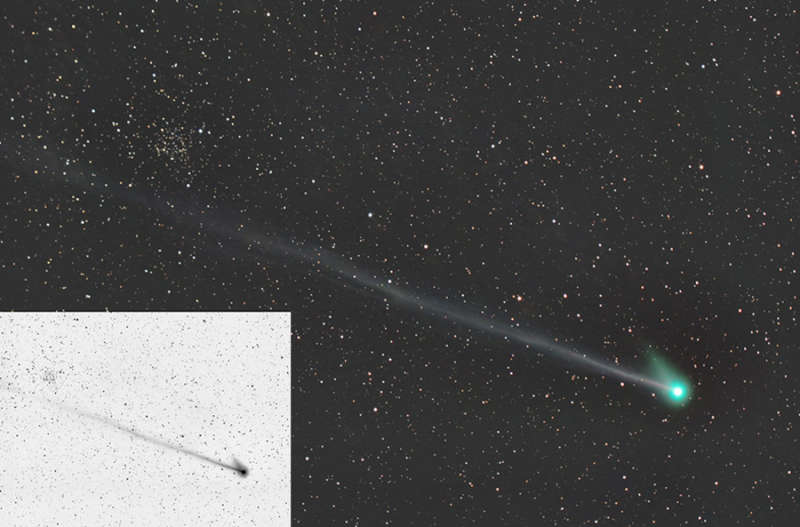Credit & Copyright: Rich Richins
Explanation:
Of the many comets named for discoverer
Robert McNaught, the one cataloged as
C/2009 R1 is gracing dawn skies for
northern hemisphere observers this month.
Seen here on June 13th from southern New Mexico,
this
Comet McNaught's long ion tail sweeps across the
telescopic field of view (a negative image is inset).
Remarkably, the ion tail easily stretches past background
star cluster NGC 1245
(upper left) in the constellation Perseus,
about 1.5 degrees from the comet's lovely
greenish head or coma.
The coma also sports a short, stubby, dust tail.
Of course, the
comet and background stars
move at different rates
through planet Earth's skies.
But a digital processing of many short exposures allowed
frames of comet and stars to be
separated, registered, and recombined in the final image.
To see the comet separate from the background stars, just slide
your cursor over the image.
The recombined frames show off both the rich star field and faint
details of the comet.
Easy to spot in binoculars for now, McNaught will
sink into the twilight along the eastern horizon in the coming days
as it heads
toward perihelion
(closest approach to the Sun) on July 2.
1999 2000 2001 2002 2003 2004 2005 2006 2007 2008 2009 2010 2011 2012 2013 2014 2015 2016 2017 2018 2019 2020 2021 2022 2023 2024 2025 |
Январь Февраль Март Апрель Май Июнь Июль Август Сентябрь Октябрь Ноябрь Декабрь |
NASA Web Site Statements, Warnings, and Disclaimers
NASA Official: Jay Norris. Specific rights apply.
A service of: LHEA at NASA / GSFC
& Michigan Tech. U.
|
Публикации с ключевыми словами:
Comet McNaught - star cluster - Комета МакНота - звездное скопление
Публикации со словами: Comet McNaught - star cluster - Комета МакНота - звездное скопление | |
См. также:
Все публикации на ту же тему >> | |
Мнения читателей [4]
